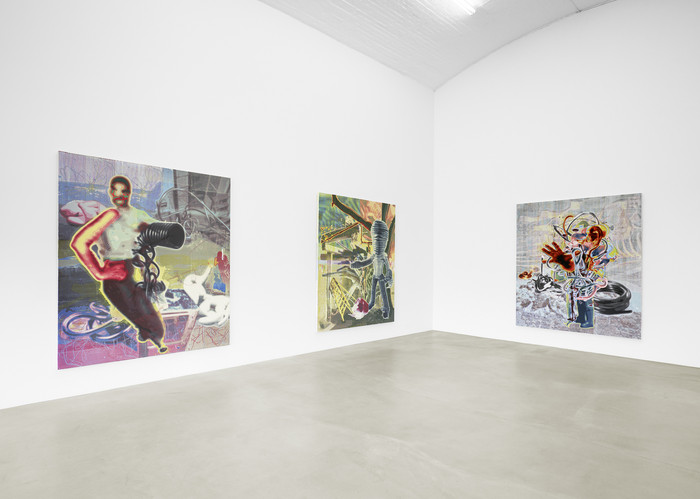Markus Oehlen
29 Apr - 19 Jun 2011
MARKUS OEHLEN
29 April - June 2011
On the occasion of Gallery Weekend Berlin 2011, Gerhardsen Gerner has the great pleasure of announcing its first solo exhibition with Markus Oehlen.
The painter, musician and sculptor Markus Oehlen, born in Krefeld in 1956, belongs to an artistic generation that once spoke in the Punk style of “No Future.” Now, for the first time in 16 years, Markus Oehlen is showing his work again in Berlin. We are enormously pleased to be able to present the artist’s outstanding new paintings.
Oehlen studied at the Kunstakademie Düsseldorf between 1976 and 1982, during which time he was also a drummer in the band Charley’s Girls and its successor Fehlfarben und Mittagspause. He was co-founder of the legendary “Ratinger Hof” in Düsseldorf, the city in which he worked during the wild 1980s as one of the leading representatives of the so-called “Neue Wilde”, alongside artists like Martin Kippenberger, Werner Büttner or Walter Dahn (Cologne). The art, fashion, music, literature, film and theatre of this generation became linked in a comprehensive crossover—the artists adapted to one another’s respective domains, motifs, methods, and codes and thus created new hybrid forms, the polar patterns of thought acting as foils to one another. Since 2002, Oehlen has been a professor at the Academy of Fine Arts, Munich.
Markus Oehlen’s paintings are multi-layered, complex entities whose forms seem to push underwater bubbles to the surface. With their many overlapping layers, Oehlen’s works appear to be cartographies drawn from memory. One could also speculate that they (and they alone) are capable of laying bare previously concealed phenomena and dimensions of the world. In the planes that make up his paintings, Oehlen re-mixes found images, compressing them and forging new ones.
The artist dissolves specific layers into a mist, producing a kind of digital effect. This is reinforced on a compositional level by patterned striations, a continuous renewal of defined forms through stacked colours (much like the effect of an infrared recording) and pixel-like elements. Yet, this digitalized effect is produced with entirely conventional techniques, such as silkscreen, photocopying, or linoleum printing. Markus Oehlen has been experimenting with these modes of reproduction, integrating them in collage-like ways into his works, since 1995—around the same time that computer technology was developing the first solutions for creating a spatial effect within a digital image.
In their complex structuring and digital references, Markus Oehlen’s paintings have the effect of an image interference. In them, reality seems to solidify as a flickering simulacrum.
Markus Oehlen ́s work has been featured in numerous exhibitions, including a solo exhibition at the Kunsthalle Gießen and the group exhibition “Die Bilder tun was mit mir...” at the Museum Frieder Burda, Baden-Baden (both in 2010); at the Centro Cultural Andratx (2008-2009); at ZKM in Karlsruhe (2008); at the Ursula Blickle Foundation and at the Kunstverein Frankfurt (both in 2007); at the Haus der Kunst in Münich (2005); and at the Hamburger Bahnhof, Berlin (2003).
29 April - June 2011
On the occasion of Gallery Weekend Berlin 2011, Gerhardsen Gerner has the great pleasure of announcing its first solo exhibition with Markus Oehlen.
The painter, musician and sculptor Markus Oehlen, born in Krefeld in 1956, belongs to an artistic generation that once spoke in the Punk style of “No Future.” Now, for the first time in 16 years, Markus Oehlen is showing his work again in Berlin. We are enormously pleased to be able to present the artist’s outstanding new paintings.
Oehlen studied at the Kunstakademie Düsseldorf between 1976 and 1982, during which time he was also a drummer in the band Charley’s Girls and its successor Fehlfarben und Mittagspause. He was co-founder of the legendary “Ratinger Hof” in Düsseldorf, the city in which he worked during the wild 1980s as one of the leading representatives of the so-called “Neue Wilde”, alongside artists like Martin Kippenberger, Werner Büttner or Walter Dahn (Cologne). The art, fashion, music, literature, film and theatre of this generation became linked in a comprehensive crossover—the artists adapted to one another’s respective domains, motifs, methods, and codes and thus created new hybrid forms, the polar patterns of thought acting as foils to one another. Since 2002, Oehlen has been a professor at the Academy of Fine Arts, Munich.
Markus Oehlen’s paintings are multi-layered, complex entities whose forms seem to push underwater bubbles to the surface. With their many overlapping layers, Oehlen’s works appear to be cartographies drawn from memory. One could also speculate that they (and they alone) are capable of laying bare previously concealed phenomena and dimensions of the world. In the planes that make up his paintings, Oehlen re-mixes found images, compressing them and forging new ones.
The artist dissolves specific layers into a mist, producing a kind of digital effect. This is reinforced on a compositional level by patterned striations, a continuous renewal of defined forms through stacked colours (much like the effect of an infrared recording) and pixel-like elements. Yet, this digitalized effect is produced with entirely conventional techniques, such as silkscreen, photocopying, or linoleum printing. Markus Oehlen has been experimenting with these modes of reproduction, integrating them in collage-like ways into his works, since 1995—around the same time that computer technology was developing the first solutions for creating a spatial effect within a digital image.
In their complex structuring and digital references, Markus Oehlen’s paintings have the effect of an image interference. In them, reality seems to solidify as a flickering simulacrum.
Markus Oehlen ́s work has been featured in numerous exhibitions, including a solo exhibition at the Kunsthalle Gießen and the group exhibition “Die Bilder tun was mit mir...” at the Museum Frieder Burda, Baden-Baden (both in 2010); at the Centro Cultural Andratx (2008-2009); at ZKM in Karlsruhe (2008); at the Ursula Blickle Foundation and at the Kunstverein Frankfurt (both in 2007); at the Haus der Kunst in Münich (2005); and at the Hamburger Bahnhof, Berlin (2003).

